Discover 35 hidden attractions, cool sights, and unusual things to do in Montreal (Canada). Don't miss out on these must-see attractions: Montreal Science Centre, Musée d'art contemporain de Montréal, and Montreal Museum of Fine Arts. Also, be sure to include Pointe-à-Callière in your itinerary.
Below, you can find the list of the most amazing places you should visit in Montreal (Québec).
Table of Contents
Montreal Science Centre
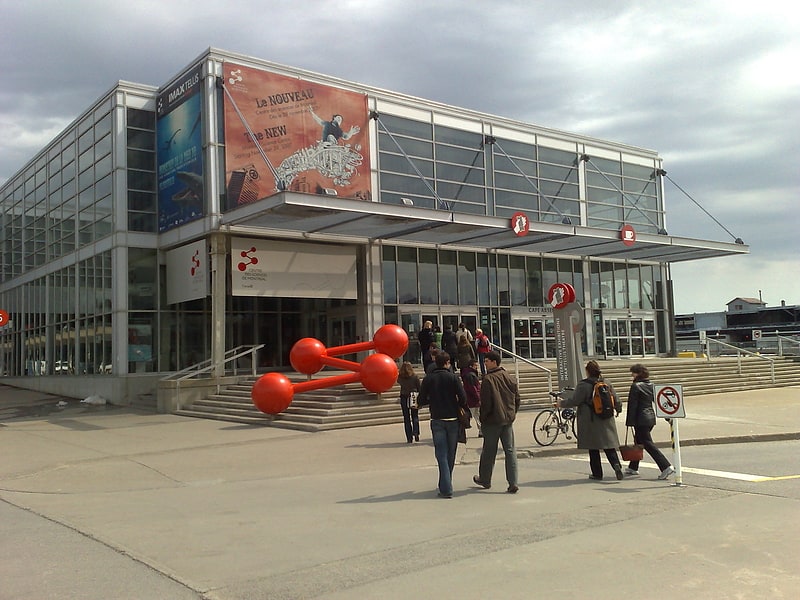
Museum in Montreal, Quebec. The Montreal Science Centre is a science museum in Montreal, Quebec, Canada. It is located on the King Edward Pier in the Old Port of Montreal. Established in 2000 and originally known as the iSci Centre, the museum changed its name to the Montreal Science Centre in 2002. The museum is managed by the Old Port of Montreal Corporation. The museum is home to interactive exhibitions on science and technology as well as an IMAX theatre.[1]
Address: 2 Rue de la Commune O, H2Y 4B2 Montréal (Ville-Marie District)
Musée d'art contemporain de Montréal
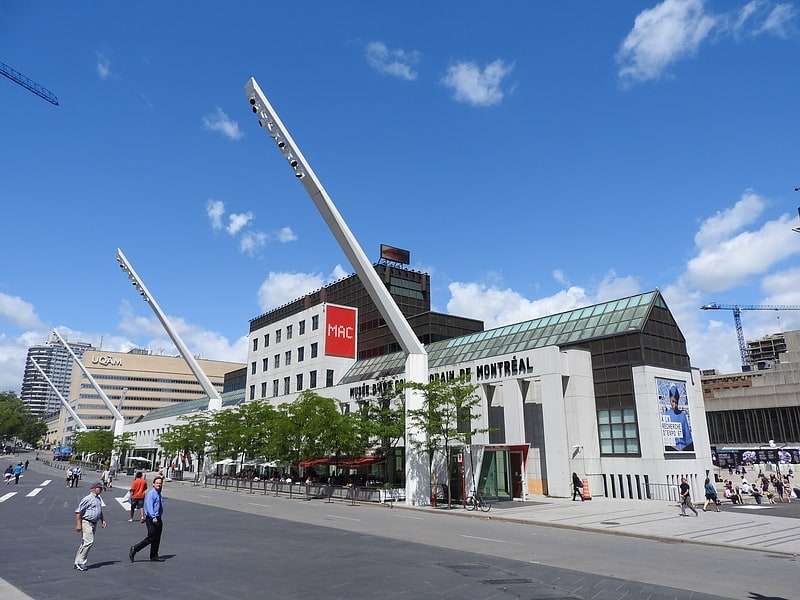
Post-1939 visual works and Québec artists. The Musée d'art contemporain de Montréal is a contemporary art museum in Montreal, Quebec, Canada. It is located on the Place des festivals in the Quartier des spectacles and is part of the Place des Arts complex.
Founded in 1964, it is Canada's first museum devoted to contemporary art. Initially housed in the Place Ville-Marie, the museum moved into the premises of the Château Dufresne in 1965, followed by an exhibition gallery from Expo 67 in 1968. In 1992, the museum moved to its current premises at Place des Arts in Montreal.[2]
Address: 185 Rue Sainte-Catherine O, H2X 3X5 Montréal (Ville-Marie District)
Montreal Museum of Fine Arts
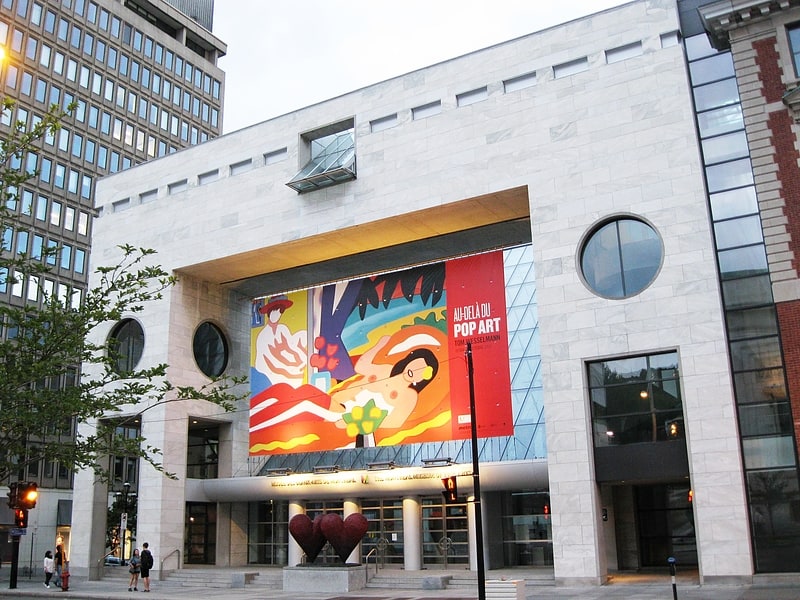
Canadian art and global exhibits. The Montreal Museum of Fine Arts is an art museum in Montreal, Quebec, Canada. It is the largest art museum in Canada by gallery space. The museum is located on the historic Golden Square Mile stretch of Sherbrooke Street.
The MMFA is spread across five pavilions, and occupies a total floor area of 53,095 square metres (571,510 sq ft), 13,000 (140,000 sq ft) of which are exhibition space. With the 2016 inauguration of the Michal and Renata Hornstein Pavilion for Peace, the museum campus was expected to become the eighteenth largest art museum in North America. The permanent collection included approximately 44,000 works in 2013. The original "reading room" of the Art Association of Montreal was the precursor of the museum's current library, the oldest art library in Canada.
The Montreal Museum of Fine Arts is a member of the International Group of Organizers of Large-scale Exhibitions, also known as the Bizot Group, a forum which allows the leaders of the largest museums in the world to exchange works and exhibitions.
Founded in 1860, it is the oldest art museum in Canada. In 2020, it was the most visited art museum in Canada.[3]
Address: 1380 Rue Sherbrooke Ouest, H3G 1J5 Montréal (Ville-Marie District)
Pointe-à-Callière

Excavations and historic buildings. Pointe-à-Callière Museum is a museum of archaeology and history in Old Montreal, Quebec, Canada. It was founded in 1992 as part of celebrations to mark Montreal's 350th birthday. The museum has collections of artifacts from the First Nations of the Montreal region that illustrate how various cultures coexisted and interacted, and how the French and British regimes influenced the history of this territory over the years. The site of Pointe-à-Callière has been included in Montreal’s Birthplace National Historic Site since its designation in 1924.
It receives more than 350,000 visitors a year. Nearly 4.5 million people have come to the museum since it opened in 1992. It has received more than fifty national and international awards, including those in museography, architecture, and for cultural, educational and community activities. The museum is affiliated with: the Canadian Museums Association, the Canadian Heritage Information Network, and the Virtual Museum of Canada.
The museum complex comprises three archaeological sites: Pointe-à-Callière, Place Royale and 214 Place d'Youville; the archaeological field school at Fort Ville-Marie; Montreal's first Catholic cemetery; the William collector sewer; an archaeological crypt: Place Royale; a heritage building: the former Youville Pumping Station; 165-169 Place d’Youville, the Mariners House; and archaeological collections of over a million objects.[4]
Address: 350 Place Royale, H2Y 3Y5 Montréal (Ville-Marie District)
Mount Royal
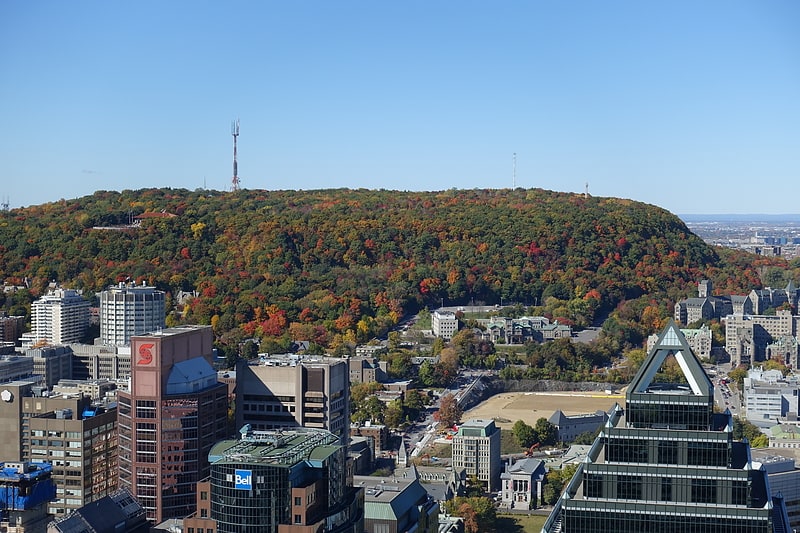
Mountain with a lookout and all-year park. Mount Royal is a large intrusive rock hill or small mountain in the city of Montreal, immediately west of Downtown Montreal, Quebec, Canada. The best-known hypothesis for the origin of the name Montreal is that the name is taken from Mount Royal.
The hill is part of the Monteregian Hills situated between the Laurentians and the Appalachian Mountains. It gave its Latin name, Mons Regius, to the Monteregian chain. The hill consists of three peaks: Colline de la Croix (or Mont Royal proper) at 233 m (764 ft), Colline d'Outremont (or Mount Murray, in the borough of Outremont) at 211 m (692 ft), and Westmount Summit at 201 m (659 ft) elevation above mean sea level.[5]
St-Laurent
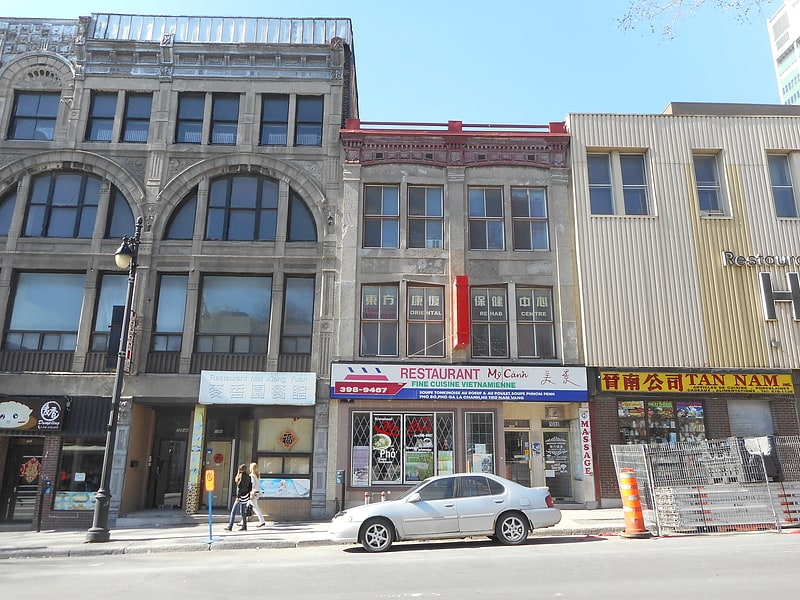
Street in Montreal, Quebec. Saint Laurent Boulevard also known as Saint Lawrence Boulevard is a major street in Montreal, Quebec, Canada. A commercial artery and cultural heritage site, the street runs north–south through the near-centre of city and is nicknamed The Main which is the abbreviation for "Main Street".[6]
McCord Museum

Museum in Montreal, Quebec. The McCord Museum is a public research and teaching museum dedicated to the preservation, study, diffusion, and appreciation of Canadian history. The museum, whose full name is McCord Museum of Canadian History, is located next to McGill University, in the downtown core of Montreal, Quebec, Canada.[7]
Address: 690 Rue Sherbrooke Ouest, H3A 1E9 Montréal (Ville-Marie District)
Montreal Biosphère
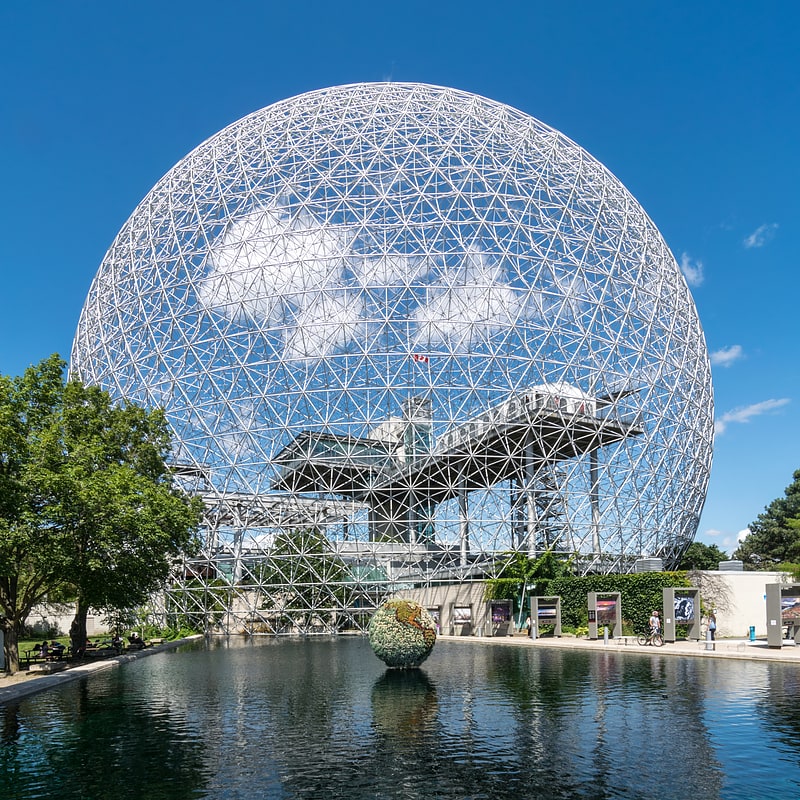
Eco-related exhibits in a geodesic dome. The Biosphere, also known as the Montreal Biosphere, is a museum dedicated to the environment in Montreal, Quebec, Canada. It is housed in the former United States pavilion constructed for Expo 67 located within the grounds of Parc Jean-Drapeau on Saint Helen's Island. The museum's geodesic dome was designed by Buckminster Fuller.[8]
Address: 160 Tour-de-l'Isle, H3C 4G8 Montreal
Canadian Centre for Architecture
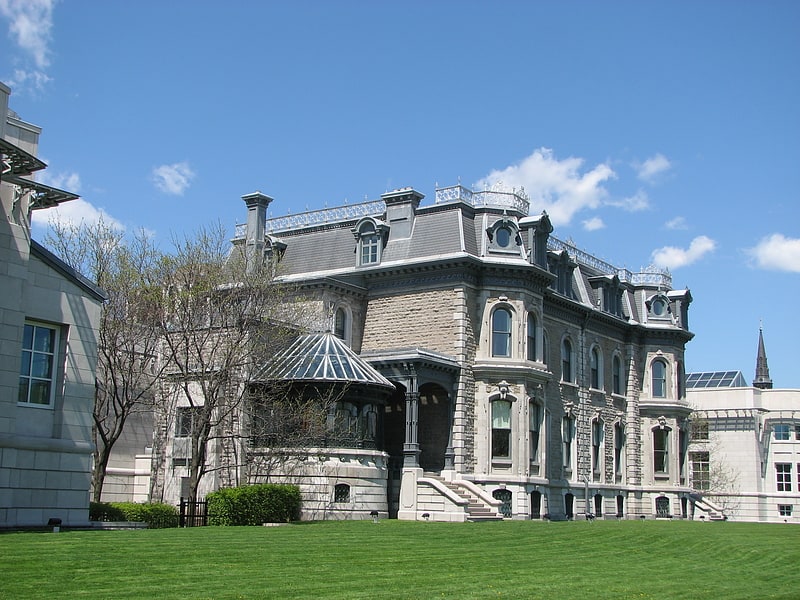
Museum in Montreal, Quebec. The Canadian Centre for Architecture is a museum of architecture and research centre in Montreal, Quebec, Canada. It is located at 1920 Baile Street, between Fort Street and Saint-Marc Street in what was once part of the Golden Square Mile. Today, it is considered to be located in the Shaughnessy Village neighbourhood of the borough of Ville-Marie.
Phyllis Lambert is the founding director emeritus, Bruce Kuwabara is chair of the board of trustees, Giovanna Borasi is the director. It was designed and built by Peter Rose.
The CCA contains a large library and archives, and is host to various exhibits throughout the year. It is also home to a study centre open to the general public. The CCA provides educational programs and cultural activities.
The CCA also has an architectural garden located on the southern side of René Lévesque Boulevard. The sculpture garden was designed by architect Melvin Charney.[9]
Address: 1920 Rue Baile, H3H 2S6 Montréal (Ville-Marie District)
Saint Joseph's Oratory
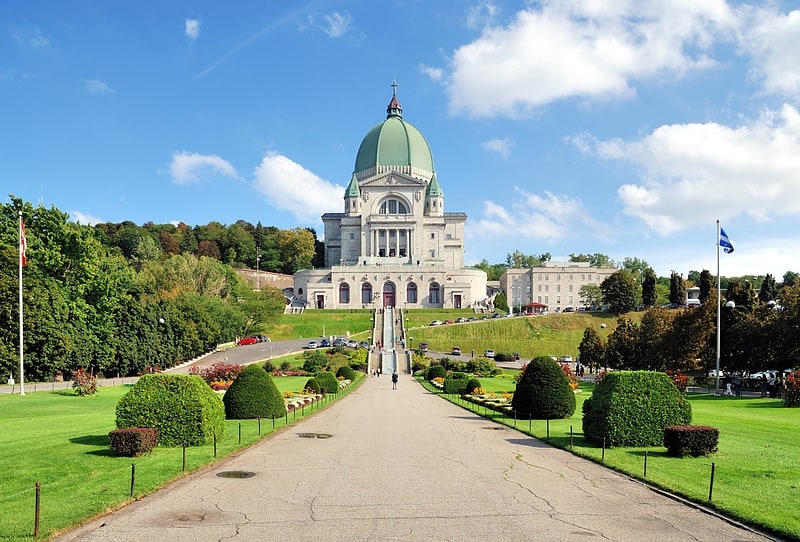
Minor basilica in Montreal, Quebec. Saint Joseph's Oratory of Mount Royal is a Roman Catholic minor basilica and national shrine located at 3800 Queen Mary Road in the Côte-des-Neiges neighborhood on Mount Royal's Westmount Summit in Montreal, Quebec. It is a National Historic Site of Canada and is Canada's largest church, with one of the largest church domes in the world. Founded in 1904 by Saint André Bessette in his patron saint, Saint Joseph's honour, the Oratory was brought alive through the work and ingenuity of numerous architects and thousands of workers in a process spanning six decades. With its monumental scale, Renaissance Revival facade and contrasting Art Deco interior, the Oratory is recognizable not just in Montreal but around the world, attracting more than 2 million visitors and pilgrims to its steps each year.
The Oratory is the highest building in Montreal, rising more than 30 meters above Mount Royal's summit, allowing it to be seen from many kilometers away. It is one of the few buildings that violates the height restriction under the municipal building code of Montreal, which limits the height of any building, including skycrapers, from surpassing the height of Mount Royal.
Since 2018, the dome and lantern atop the Oratory have undergone a series of renovations expected to be completed in 2022 by architecture firms Atelier TAG and Architecture49. The C$80 million project will create safe access to the lantern which will allow for an unprecedented 360-degree view over the mountain of the city.[10]
Address: 3800 Chemin Queen Mary, H3V 1H6 Montréal (Côte-des-Neiges-Notre-Dame-de-Gráce)
Insectarium
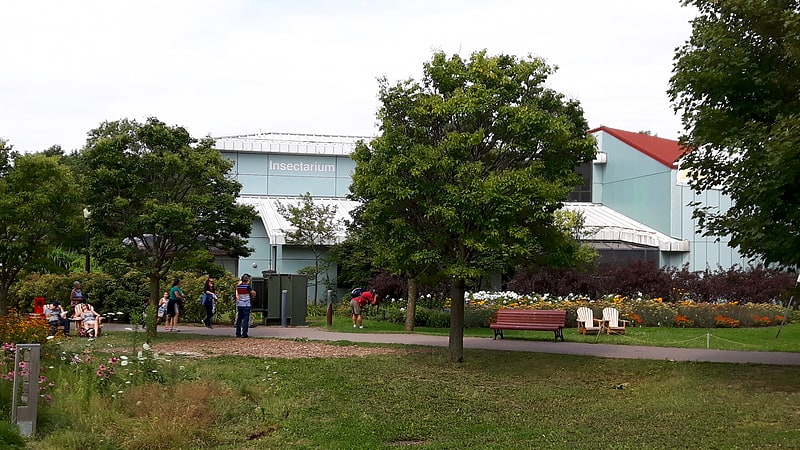
Large insect museum with live exhibits. The Montreal Insectarium is a natural history museum located in Montreal, Quebec, Canada, featuring a large quantity of insects from all around the world. It is the largest insect museum in North America and among the largest insectariums worldwide. It was founded by Georges Brossard and opened on February 7, 1990. Its average attendance is 400,000 visitors per year. It displays both live and dead insect collections, from butterflies to bees and ants.
It is one of the city's most popular tourist attractions, along with the Montreal Botanical Garden, Montreal Planetarium and the Montreal Biodome.
Seen from the sky, the Montréal Insectarium resembles a stylized insect. This can also be seen from the observatory of Montréal's Olympic Stadium.[11]
Address: 4581 Rue Sherbrooke E, H1X 2B2 Montréal (Rosemont-La Petite-Patrie)
Montreal Biodome
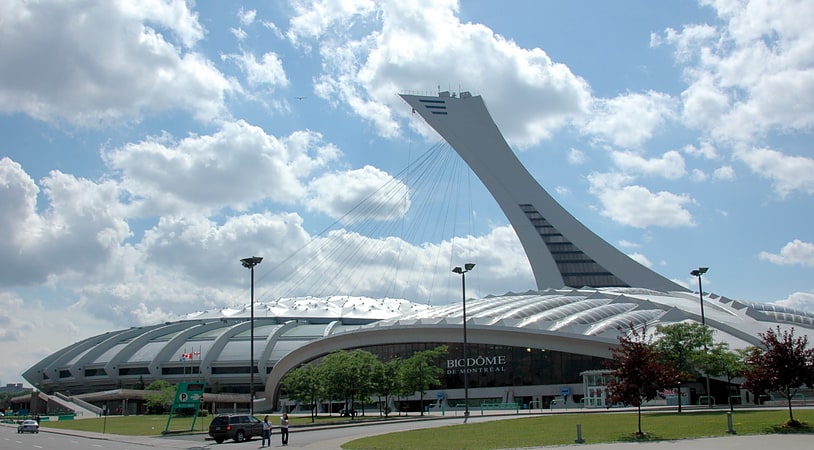
Museum in Montreal, Quebec. The Montreal Biodome is a facility located at Olympic Park in the Mercier–Hochelaga-Maisonneuve neighbourhood of Montreal, Quebec, Canada, that allows visitors to walk through replicas of four ecosystems found in the Americas. The building was originally constructed for the 1976 Olympic Games as a velodrome. It hosted both track cycling and judo events. Renovations on the building began in 1989 and in 1992 the indoor nature exhibit was opened.
The Montreal Biodome is one of four facilities that make part of the largest natural science museum complex in Canada, Space for Life, which also includes the Montreal Insectarium, Montreal Botanical Garden, and Rio Tinto Alcan Planetarium. It is an accredited member of both the Association of Zoos and Aquariums (AZA) and the Canada's Accredited Zoos and Aquariums association (CAZA).[12]
Address: 4777 Pierre de-Coubertin Ave, H1V 1B3 Montreal (Mercier-Hochelaga-Maisonneuve)
Notre-Dame Basilica
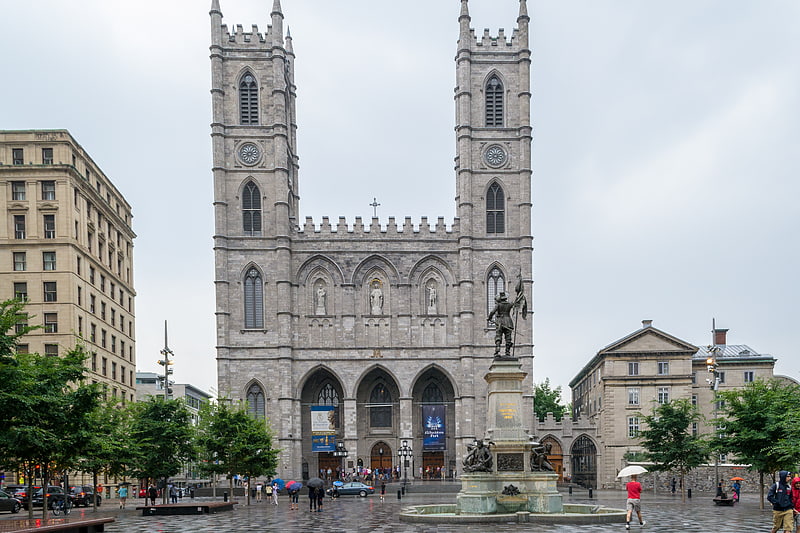
Towering Gothic Revival church. Notre-Dame Basilica is a basilica in the historic district of Old Montreal, in Montreal, Quebec, Canada. The church is located at 110 Notre-Dame Street West, at the corner of Saint Sulpice Street. It is located next to the Saint-Sulpice Seminary and faces the Place d'Armes square.
The interior of the church is amongst the most dramatic in the world and regarded as a masterpiece of Gothic Revival architecture. The vaults are coloured deep blue and decorated with golden stars, and the rest of the sanctuary is decorated in blues, azures, reds, purples, silver, and gold. It is filled with hundreds of intricate wooden carvings and several religious statues. Unusual for a church, the stained glass windows along the walls of the sanctuary do not depict biblical scenes, but rather scenes from the religious history of Montreal. It also has a Casavant Frères pipe organ, dated 1891, which comprises four keyboards, 92 stops using electromagnetic action and an adjustable combination system, 7000 individual pipes and a pedal board.
Approximately 11 million people visit Notre-Dame Basilica every year, making it one of the most visited monuments in North America.[13]
Address: 110 Rue Notre-Dame Ouest, H2Y 1T2 Montréal (Ville-Marie District)
Centre d'histoire de Montréal
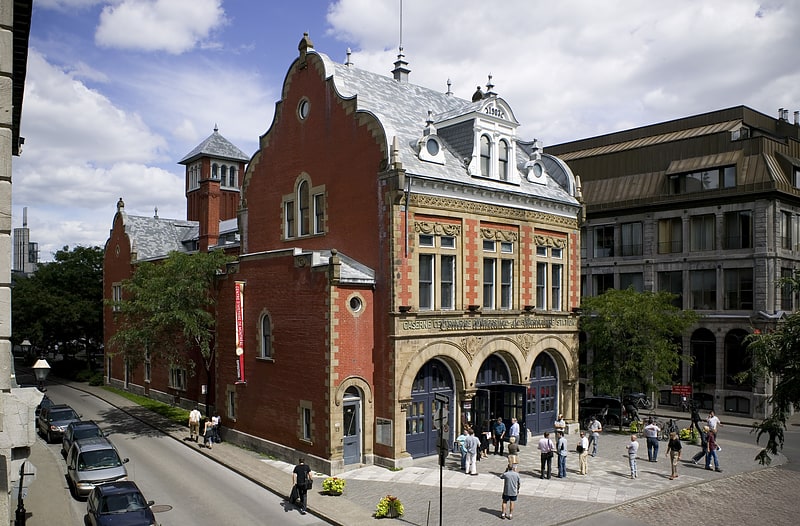
Museum in Montreal, Québec. The Centre d'histoire de Montréal is a museum in Montreal, Quebec, Canada. It is located at 335 Place d'Youville in Old Montreal, in the borough of Ville-Marie. The museum is dedicated to the history of Montreal.[14]
Address: 335 place d'Youville, H2Y 3T1 Montreal (Ville-Marie District)
Maison Saint-Gabriel

Museum in Montreal, Quebec. The Maison Saint-Gabriel Museum is located in Montreal, Quebec and is dedicated to preserving the history, heritage and artifacts of the settlers of New France in the mid 17th century. The museum consists of a small farm, which has been administered for more than 300 years by the Sisters of the Congregation of Notre Dame of Montreal, founded by Marguerite Bourgeoys in Montreal in 1658.
The site was designated a National Historic Site of Canada in 2007.[15]
Address: 2146 Place Dublin, H3K 2A2 Montreal
Montreal Botanical Garden
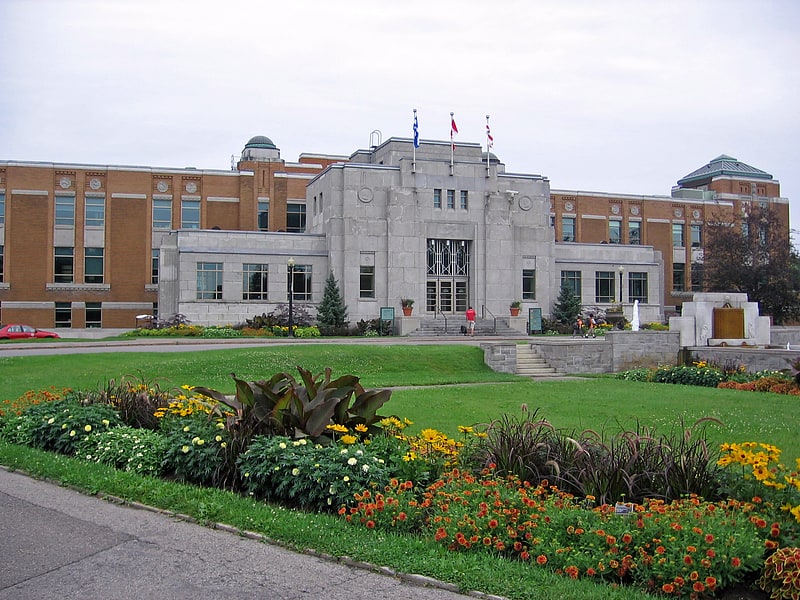
Botanical oasis with thematic exhibits. The Montreal Botanical Garden is a large botanical garden in Montreal, Quebec, Canada comprising 75 hectares of thematic gardens and greenhouses. It was designated a National Historic Site of Canada in 2008 as it is considered to be one of the most important botanical gardens in the world due to the extent of its collections and facilities.[16]
Address: 4101 Sherbrooke St. E, H1X 2B2 Montreal (Rosemont-La Petite-Patrie)
Redpath Museum
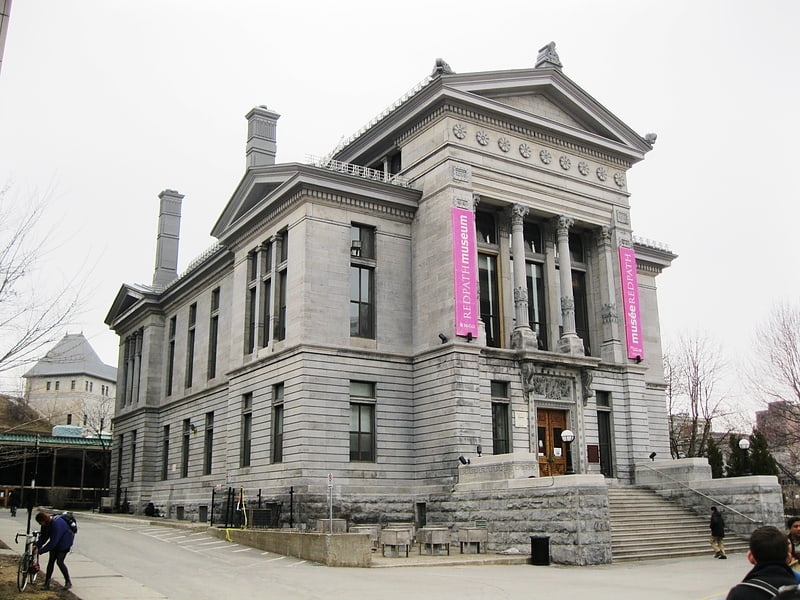
University natural history collection. The Redpath Museum is a museum of natural history belonging to McGill University and located on the university's campus at 859 Sherbrooke Street West in Montreal, Quebec. It was built in 1882 as a gift from the sugar baron Peter Redpath.
It houses collections of interest to ethnology, biology, paleontology, and mineralogy/geology. The collections were started by some of the same individuals who founded the Smithsonian and Royal Ontario Museum collections. The current director is Hans Larsson. Commissioned by Redpath to mark the 25th anniversary of Sir John William Dawson's appointment as Principal, the Museum was designed by A.C. Hutchison and A.D. Steele. McGill University's Redpath Museum website characterizes it as an "idiosyncratic expression of eclectic Victorian Classicism" as well as "an unusual and late example of the Greek Revival in North America."
It is the oldest building built specifically to be a museum in Canada. Both the museum's interior and exterior have been utilized as a set, for movies and commercials.[17]
Address: 859 rue Sherbrooke Ouest, H3A 0C4 Montreal (Ville-Marie District)
Notre-Dame-de-Bon-Secours Chapel
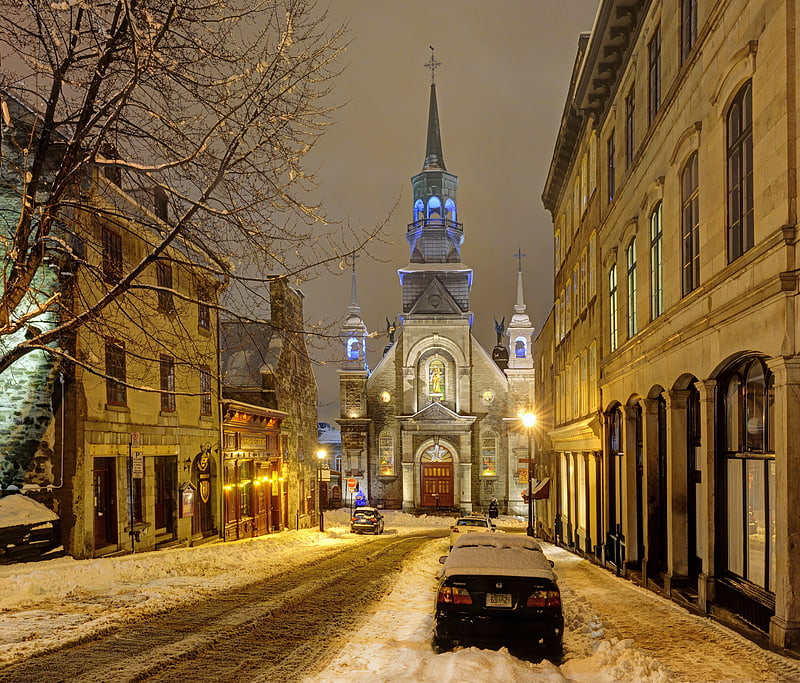
18th-century worship site and saint's tomb. The Notre-Dame-de-Bon-Secours Chapel is a church in the district of Old Montreal in Montreal, Quebec. One of the oldest churches in Montreal, it was built in 1771 over the ruins of an earlier chapel. The church is located at 400 Saint Paul Street East at Bonsecours Street, just north of the Bonsecours Market in the borough of Ville-Marie.[18]
Address: 400 Rue Saint Paul Est, H2Y 1H4 Montréal (Ville-Marie District)
Plaza Côte-des-Neiges

Mall in Montreal, Québec
Address: 6700 Chemin de la Côte-des-Neiges, H3S 2B2 Montréal (Côte-des-Neiges-Notre-Dame-de-Gráce)
Vampire
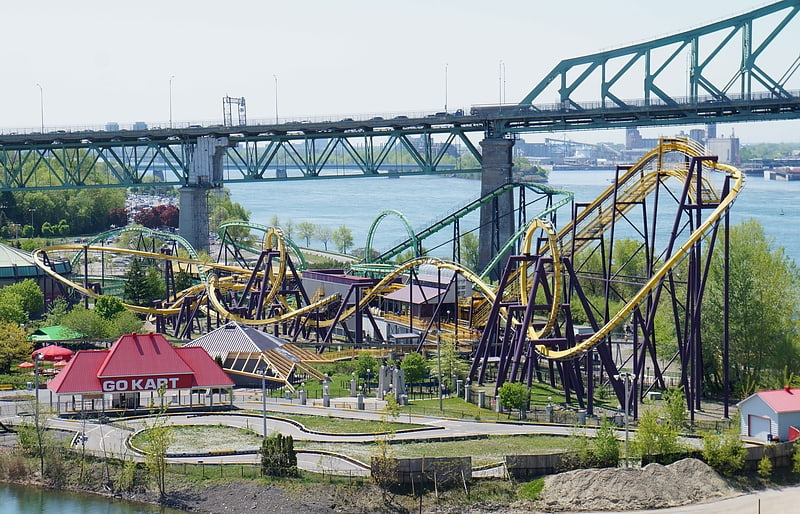
Le Vampire is an inverted roller coaster at La Ronde amusement park in Montreal, Quebec, Canada, designed by the Swiss firm Bolliger & Mabillard. It is a mirror image of Batman: The Ride, but the roller coaster has no association to the Batman media franchise and was given an unrelated name and a slightly different cosmetic appearance. The track is 823 metres in length and reaches a height of nearly 32 metres. Riders sit with their legs dangling such as on a ski chairlift and reach speeds of up to 80.5 km/hour and loop head-over-heels five times. The Vampire can carry up to 1,400 riders per hour.
The ride was closed due to an accident on July 6, 2012. It opened for the first time since the incident on August 13, 2012. On September 3, 2015, the park announced that the ride would run backwards for a limited time during the 2016 season and become part of a new section of the park.
Le Vampire was constructed by Martin & Vleminckx.[19]
Address: La Ronde, Montreal
Mary

Grand church dating to the 19th century. Mary, Queen of the World Cathedral or in full Mary, Queen of the World and St. James the Great Cathedral is a minor basilica in Montreal, Quebec, Canada, and the seat of the Roman Catholic archdiocese of Montreal. It is the third largest church in Quebec after Saint Joseph's Oratory and the Basilica of Sainte-Anne-de-Beaupré east of Quebec City. The building is 101 m in length, 46 m in width, and a maximum height of 77 m at the cupola, the diameter of which is 23 m.
The church is located at 1085 Cathedral Street at the corner of René Lévesque Boulevard and Metcalfe Street, near the Bonaventure metro station and Central Station in downtown Montreal. It and the connected Archdiocese main buildings form the eastern side of Place du Canada, and occupies of dominant presences on Dorchester Square.[20]
Address: 1085 de la Cathedrale, H3B 2V3 Montreal (Ville-Marie District)
Beaver Lake

Lake in Québec, Canada. The Beaver Lake is an artificial basin fitted in 1938 on a former swamp located on the Mount Royal, in Montreal, Quebec, Canada. It was designed by architect Frederick Todd.
It takes its name from an old beaver dam discovered during the work.[21]
Address: 1260 chemin Remembrance, H2V 2P9 Montréal (Ville-Marie District)
Parc-nature de l'Île-de-la-Visitation

Park in Montreal, Quebec. L'Île-de-la-Visitation Nature Park is a large nature park in the Ahuntsic-Cartierville and Montréal-Nord boroughs of Montreal, Quebec, Canada.
Much of the park is on Île de la Visitation, with the rest being opposite the island on the shore of the Island of Montreal. Bridges connect the two sections. The park was established in 1984 during the renovation of the Rivière des Prairies generating station. It has an area of 34 hectares.
The footpaths along the shore allow for walking and offer views of the Rivière des Prairies. The park has 8.8 kilometres (5.5 mi) of hiking trails and 3.6 kilometres (2.2 mi) of bike paths. Fishing is allowed in designated areas.
Various historical monuments (Milling site, Maison du Pressoir, Maison du Meunier) and picnic tables are located along the trail.
In winter, cross-country skiing trails are offered. There is also a small hill that is used for tobogganing by children.
The current of the Rivière des Prairies is calm around the island.[22]
Address: 2425, boul. Gouin Est, H2B 1X7 Montréal (Ahuntsic-Cartierville)
Parc Jean-Drapeau

Pair of islands with varied attractions. Parc Jean-Drapeau is situated to the east of downtown Montreal, Quebec, Canada, in the Saint Lawrence River. It comprises two islands, Saint Helen's Island and the artificial island Notre Dame Island.
The islands were the site of the Expo 67 World's Fair. Notre Dame Island was constructed for the exposition, and Saint Helen's Island artificially extended at its north and south ends. The park was renamed in honour of Jean Drapeau, the late mayor of Montreal and initiator of Expo 67.[23]
City Hall
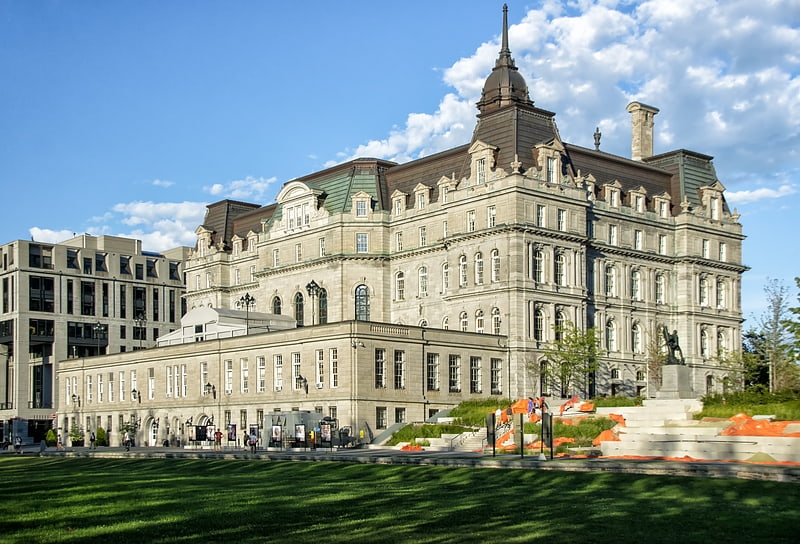
Grand building housing mayor's office. The five-storey Montreal City Hall is the seat of local government in Montreal, Quebec, Canada. It was designed by architects Henri-Maurice Perrault and Alexander Cowper Hutchison, and built between 1872 and 1878 in the Second Empire style. It is located in Old Montreal, between Place Jacques-Cartier and the Champ de Mars, at 275 Notre-Dame Street East. The closest Metro station is Champ-de-Mars, on the Orange Line.
As one of the best examples of the Second Empire style in Canada, and the first city hall to have been constructed in the country solely for municipal administration, it was designated a National Historic Site of Canada in 1984.[24]
Address: 275 Notre-Dame St. E., H2Y 1C6 Montreal (Ville-Marie District)
Goliath
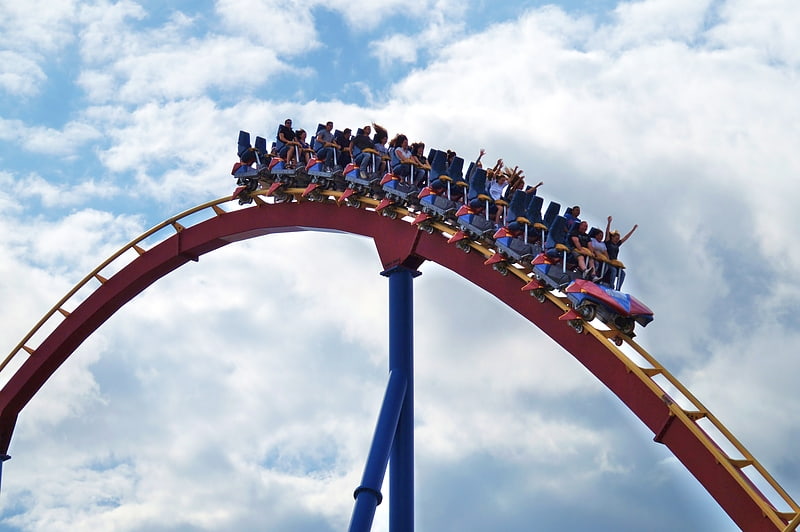
Coaster. Goliath is a steel coaster roller coaster at La Ronde located in Montreal, Quebec, Canada. Designed by Bolliger & Mabillard, it reaches a maximum height of 174.8 feet, a speed of 68.4 miles per hour and a track length of 4,038.8 feet. Construction commenced in September 2005, and the roller coaster opened to the public on May 13, 2006. Goliath was the tallest and fastest roller coaster in Canada until it was surpassed by Behemoth, at Canada's Wonderland's in 2008. Six Flags announced that Goliath would be hooked up with Virtual Reality for a New Revolution experience for the 2016 season, which was previously made as a world premiere in 2013 by a Montreal VR company.[25]
Address: La Ronde, Montreal
Bell Centre

Arena in Montreal, Quebec. Bell Centre, formerly known as Molson Centre, is a multi-purpose arena located in Montreal, Quebec, Canada. Opened on March 16, 1996, it is the home arena of the Montreal Canadiens of the National Hockey League, replacing the Montreal Forum. It is owned by the Molson family via the team's ownership group Groupe CH, and managed via Groupe CH subsidiary Evenko.
With a capacity of 21,105 in its hockey configuration, Bell Centre is the largest ice hockey arena in the world. Alongside hockey, Bell Centre has hosted major concerts, and occasional mixed martial arts and professional wrestling events. Since it opened in 1996, it has consistently been listed as one of the world's busiest arenas, usually receiving the highest attendance of any arena in Canada. In 2012, it was the fifth-busiest arena in the world based on ticket sales for non-sporting events.[26]
Address: Montreal, 1909, avenue des Canadiens-de-Montréal
Dieppe Park
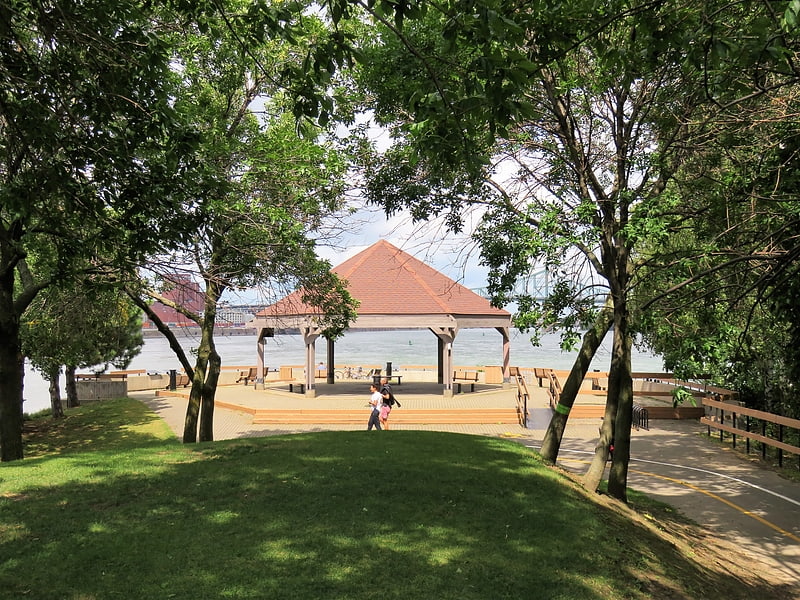
City park in Montreal, Quebec. Dieppe Park is a park in Montreal, Quebec, Canada. It is at the eastern tip of Cité du Havre, in the borough of Ville-Marie. Between 1992 and 2017, it was known as Parc de la Cité-du-Havre. In 2017 it was named Dieppe Park to mark the 75th anniversary of the Dieppe Raid.
Despite it having an area of just 7 hectares, it is categorized by the city of Montreal as one of its large parks.
The park offers an excellent view of the Old Port of Montreal, Downtown Montreal, and the Jacques Cartier Bridge. It also is a viewing point of the Montreal Fireworks Festival.
Nearby is the original Habitat 67 housing complex, the renowned Montréal landmark built for Expo 67.[27]
Address: 3400 Avenue Pierre-Dupuy, Montreal (Ville-Marie District)
Château Dufresne

Civic museum in a 20th-century mansion. The Château Dufresne is a historic building in the borough of Mercier–Hochelaga-Maisonneuve in Montreal, Quebec, Canada. It currently functions as a historic house museum.[28]
Address: 2929 Rue Jeanne-d'Arc, H1W 3W2 Montreal (Mercier-Hochelaga-Maisonneuve)
Ednör
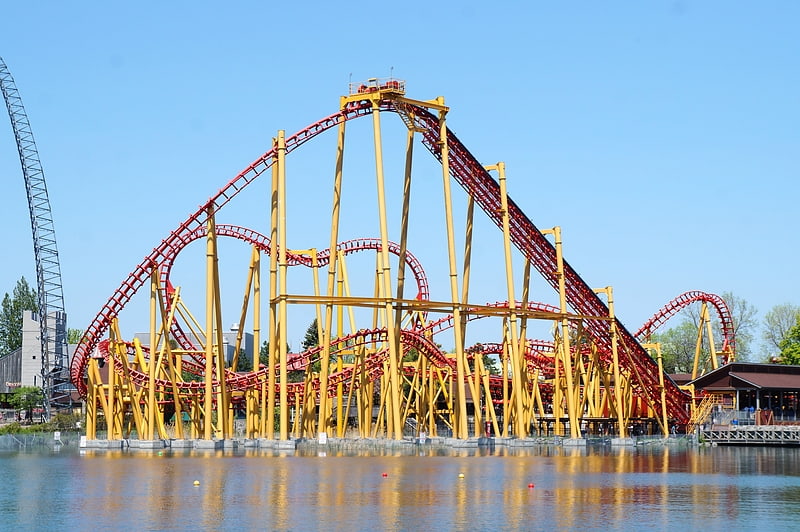
Roller coaster. Ednör – L'Attaque is a steel inverted roller coaster at La Ronde in Montreal, Quebec, Canada. Built by Vekoma, it is a standard 689-meter Suspended Looping Coaster. It debuted in 1999 as Serial Thriller at Six Flags AstroWorld in Houston, Texas. Following the closure of AstroWorld in 2005, Serial Thriller was dismantled and moved to The Great Escape and Hurricane Harbor in Queensbury, New York. After sitting idle in New York for four years, it was relocated to La Ronde and opened for the 2010 season.[29]
Address: La Ronde, Montreal
Dorchester Square
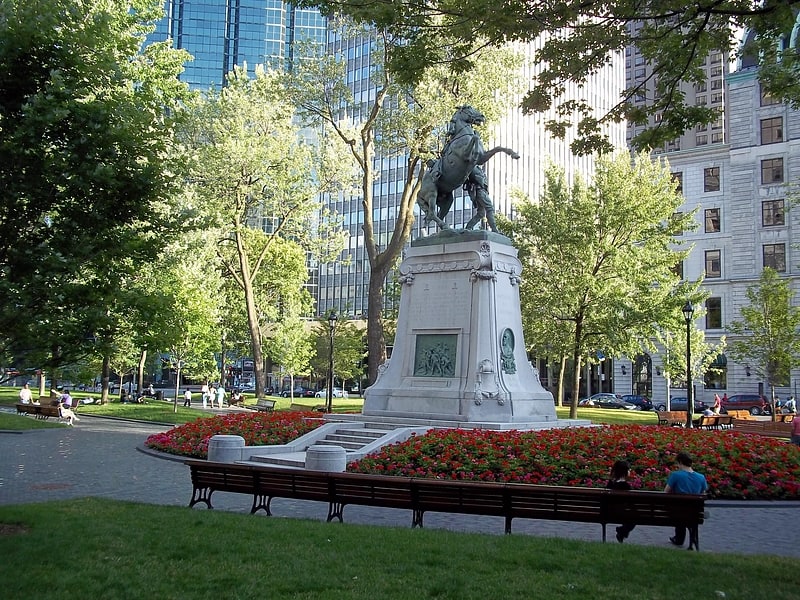
Large urban park with monuments. Dorchester Square is a large urban square in downtown Montreal. Together with Place du Canada, the area is just over 21,000 m2 or 2.1 ha of manicured and protected urban parkland bordered by René Lévesque Boulevard to the south, Peel Street to the west, Metcalfe Street to the east and Dorchester Square Street to the north. The square is open to the public 24 hours a day and forms a focal point for pedestrian traffic in the city. Until the creation of Place du Canada in 1967, the name "Dominion Square" had been applied to the entire area.
Land acquisition to build the square began in 1872 and the site was inaugurated in 1878, though it was not thoroughly completed until 1892. The square has four statues that were originally arranged in the form of a Union Jack. In 2010, $14-million was spent on a redesign, with the removal of a flower stand on the southwest corner, all monuments refurbished, new street furniture added and a lighting scheme which has greatly improved the look of the square after dark. As a nod to the fact that it was once a cemetery, small crosses have been embedded in the walkways. In addition, some lights are pointed to shine on the foliage of the many trees, allowing for an interesting nocturnal green glow in the summer. A planned renovation of Place du Canada has begun with renovations to the John A. Macdonald monument and the Cenotaph. A further renovation of Dorchester Square Street (including the bus/taxi parking area, subterranean garage entrance and exit and the kiosk) is planned, and it is possible that the square may be expanded with Dorchester Square Street converted for pedestrian use.[30]
Address: Square Dorchester, H3B 4J5 Montréal (Ville-Marie District)
Place Bonaventure
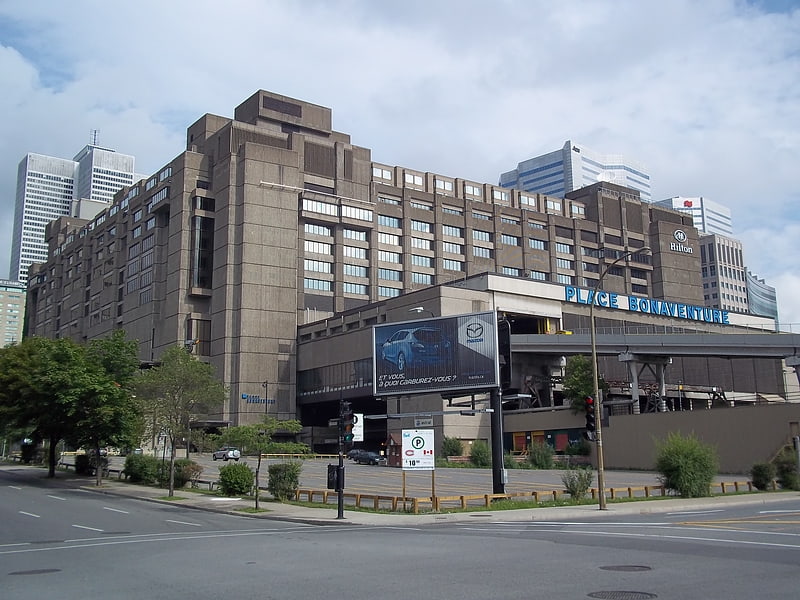
Building. Place Bonaventure is an office, exhibition, and hotel complex in Downtown Montreal, Quebec, Canada, adjacent to the city's Central Station. At 288,000 m2 in size, Place Bonaventure was the second largest commercial building in the world at the time of its completion in 1967. It is one of very few buildings in Canada to have its own postal code prefix, H5A.[31]
Address: 900 de la Gauchetière O, H5A 1E4 Montréal (Ville-Marie District)
Montreal Clock Tower
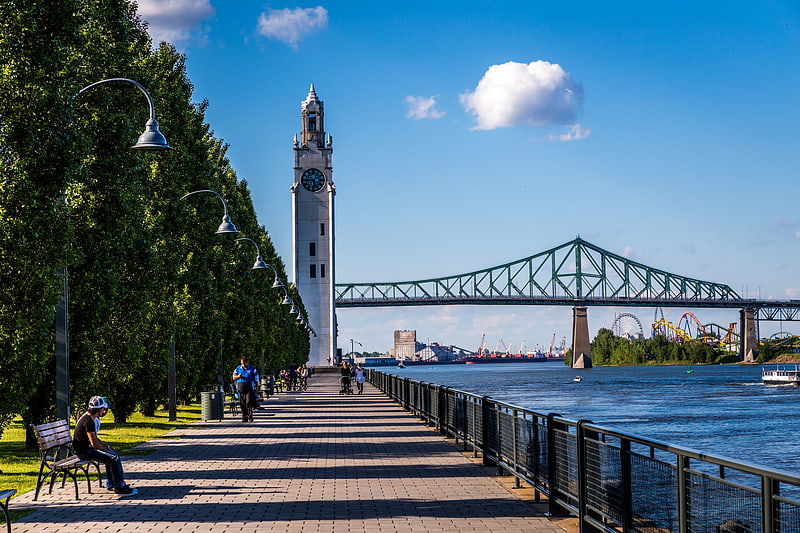
Historical harborfront clock tower. The Montreal Clock Tower, also known as the Sailor's Memorial Clock and Tour de l’Horlodge in French, is located in the borough of Ville-Marie and is situated in the Old Port of Montreal. The construction of the tower began in 1919, and was finished in 1922. The Clock Tower is 45 m tall with 192 steps from the bottom to the top of the tower. It has three observation stops along the staircase and is the outside walls of the Clock Tower are white in colour. The structure consists of the principal tower, as well as a smaller tower that is 12 m and architecturally similar to the main tower. The two towers are connected by a white 13 m curtain wall. The tower consists of four translucent clock faces. These are each 3.7 m in diameter and were designed by the English engineering firm, Gillett & Johnston.
The building of the Montreal clock tower was directed by the Montreal Harbor Commission. The commission which was formed in the year 1830 to oversea the infrastructural development of the Old Port of Montreal and was replaced by the National Harbours Board in 1936. The tower marks the entrance to the Old Port of Montreal and its erection was dedicated to the seamen who died in the First World War. It is a symbol of the port's economic contribution through grain exportation to the city of Montreal during the era of the Clock Tower's construction.[32]
Address: 1 Rue Quai de l'Horloge, H2Y 2E2 Montréal (Ville-Marie District)
Percival Molson Memorial Stadium
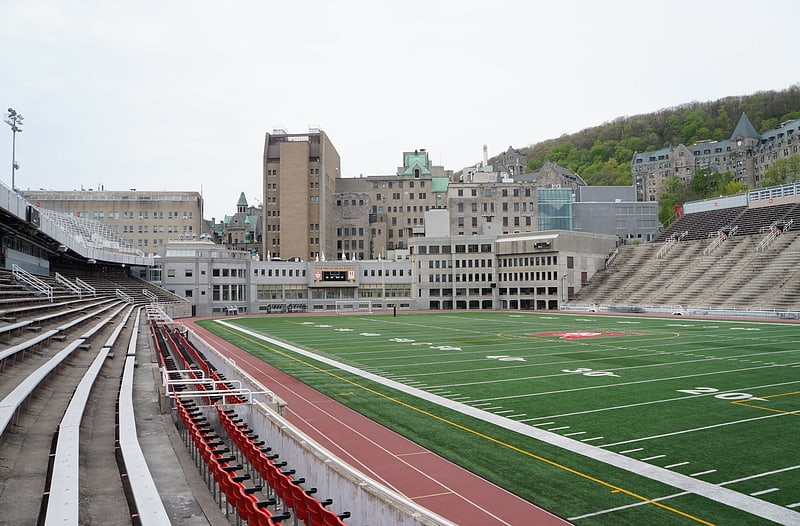
Stadium in Montreal, Quebec. Percival Molson Memorial Stadium is an outdoor football stadium located downtown on the slopes of Mount Royal in the borough of Ville-Marie in Montreal, Quebec, Canada. Named in honour of Percival Molson, it is owned by McGill University and was the home of the Montreal Alouettes of the Canadian Football League from 1954 to 1967 and has been since 1998. The stadium is also home to the McGill Redbirds and Martlets of the RSEQ, the Montreal Royal of the American Ultimate Disc League, and the Canadian Corporate Soccer League, the largest amateur corporate league in Canada. The Selwyn House Gryphons high-school football team also play their home games at the stadium. The stadium has a capacity of 20,025.[33]
Address: 475 Avenue des Pins Ouest, H2W 1S4 Montreal (Ville-Marie District)
Place des Arts
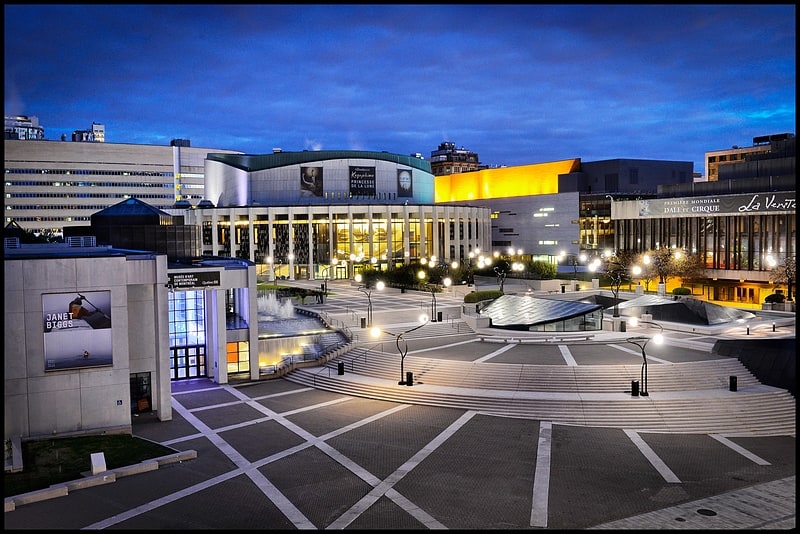
Performing arts centre in Montreal, Quebec. Place des Arts is a major performing arts centre in Montreal, Quebec, Canada, and the largest cultural and artistic complex in Canada.
Home to the Montreal Symphony Orchestra, the Orchestre Métropolitain, Les Grands Ballets Canadiens, and the Opéra de Montréal, the complex is situated between Saint Catherine and de Maisonneuve Streets, and Saint-Urbain and Jeanne-Mance streets, in an area now known as the Quartier des spectacles in the borough of Ville-Marie.
Place des Arts was an initiative of Mayor Jean Drapeau, a noted lover of opera, as part of a project to expand the downtown core eastward from the concentration of business and financial activity in the centre-west part of downtown. The Corporation George-Étienne-Cartier, named in honour of George-Étienne Cartier, a Father of Confederation and opera lover, was set up to build it, and the first part of the complex (including the Salle Wilfrid-Pelletier) was inaugurated on September 21, 1963. The other theatres were added progressively.[34]
Address: Ste-Catherine St, H2X 1Y9 Montreal (Ville-Marie District)